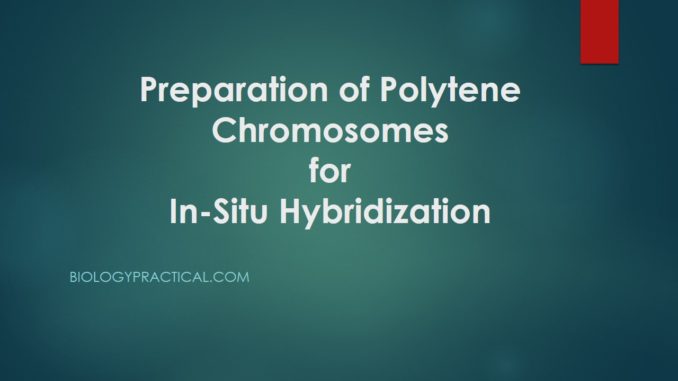
Polytene Chromosomes preparation
- Dissect out salivary glands from third-instar larvae in 0.7% NaCl.
- Transfer the salivary glands to a drop of 45 % acetic acid for 30 seconds and then transfer to a 1:2:3 mixture of lactic acid: glacial acetic acid: water and incubate for 5 minutes.
- Cover with a siliconized coverslip.
- Sandwich between two sheets of blotting paper, and tap with the blunt end of a pair of tweezers to squash the cells.
- Observe the squashing procedure by analyzing the chromosomes by phase-contrast microscopy (a 40X dry objective is ideal for this purpose).
- When the chromosome spreading is optimum, leave to fix for l to 2 hours at room temperature or overnight at 4°C.
- To remove the coverslip, immerse the preparation in liquid N, until boiling stops, level off the coverslip with the flick of a scalpel.
- Immerse the slide immediately in a jar containing 70% ethanol for at least 3 minutes.
- Slides can be kept at this stage for a long time. This is an appropriate step at which to accumulate all the slides so that they all can go into the next steps at the same time.
- When all the slides are ready, they are transferred into absolute ethanol for 3 minutes and air dried.
- Before denaturation, the slides are treated by immersion in a jar containing 2X saline sodium citrate (SSC) at 65°C for 30 minutes, followed by two immersions in 70% ethanol for 5 minutes and absolute ethanol for 5 minutes and air dried as before.
- Place the slides in freshly made 70 mM NaOH for 3 minutes in order to denature DNA.
- It is very important that this solution is made fresh every time.
- Transfer the slides to 70% ethanol for 3 minutes, absolute ethanol for 3 minutes, and air dry as before.
- Place 20
of the denatured probe on top of the chromosomes and cover with a coverslip.
- Hybridization is carried out in a humid chamber overnight at 58°C.
- After hybridization the slides are washed in the following series:
- 2X SSC at 53°Cfor 2 minutes. Check that the coverslip falls off.
- 4X SSC at room temperature for 5 minutes.
- 4X SSC containing 0.1% triton X-100at room temperature for 5 minutes.
- 4X SSC at room temperature for 5 minutes. Make sure that the last wash does not contain any triton X-100. These washing solutions can be kept and reused.
- Incubate the slides in 2% ( v/v ) fluorescein isothiocyanate (FITC)- labelled avidin in phosphate-buffered saline (PBS) for 30 minutes.
- Wash in the following series:
- 4X SSC at room temperature for 5 minutes.
- 4 X SSC containing 0.1% triton X-100 at room temperature for 5 minutes.
- 4X SSC at room temperature for 5 minutes. Make sure that the last wash does not contain any triton X-100.
- If necessary, the signal can be enhanced 5- to 10-fold by incubation for 30 minutes with 1:100 FITC anti-avidin D followed by the same series of washes.
- The preparation is now ready to be mounted for microscope examination.
- Remove the excess liquid with a paper tissue and add a drop of mounting medium containing 1
g/ml propidium iodide to counterstain DNA.
- There are several mounting media that can be used.
- The simplest one is a solution of 2.5% propyl gallate in 85% glycerol.
- This solution is economical and easy to make, but it does not set, thus needs the coverslip to be sealed.
- This can be gained by applying nail varnish on the edges.
- Other mounting mediums such as Permount or Gelvatol can also be used.
